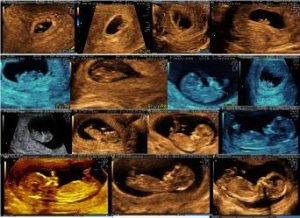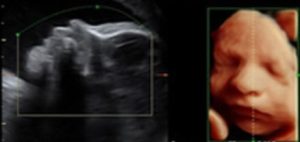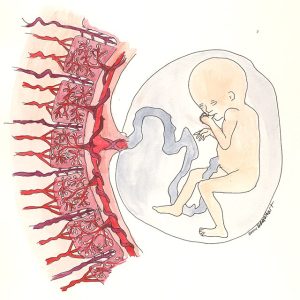Introduction
“Allons, mes enfants.”
– Come on, my children.

Learning Objectives
By the end of this chapter, you will be able to:
- Discuss the nutritional requirements during pregnancy and lactation.
- Explain the importance of a healthy lifestyle and proper health care before, during, and after pregnancy.
- Understand the guide to eating during pregnancy, including foods to avoid.
- Describe foodborne illness during pregnancy.
- Identify the benefits of breastfeeding.
- Compare the nutrient compositions of human breast milk and infant formula.
- Describe infancy and nutritional requirements during infancy.
- Explain the nutrition-related problems of infants.
- Describe Toddler years and discuss the energy and nutrient needs of toddlers.
- Discuss the feeding problems in the toddler years
The Human Life Cycle
Human bodies change significantly over time, and food fuels those changes.
People of all ages need the same basic nutrients—essential amino acids, carbohydrates, essential fatty acids, and twenty-eight vitamins and minerals—to sustain life and health. However, the amounts of nutrients needed differ. Throughout the human life cycle, the body constantly changes and goes through different periods known as stages. This chapter will focus on pregnancy, infancy, and the toddler years. Chapter 13 will focus on childhood through adolescence, and Chapter 14 will focus on the stages of adulthood. The significant stages of the human life cycle are defined as follows:
- Pregnancy. The development of a zygote into an embryo and then into a fetus in preparation for childbirth.
- Infancy. The earliest part of childhood. It is the period from birth through the first birthday.
- Toddler years. Occur during ages one to three and are the end of early childhood.
- Childhood. The period from birth to eighteen.
- Onset of Puberty. It can occur from ages nine to fourteen, which is the beginning of adolescence.
- Older adolescence. The stage that takes place between the ages of fourteen and eighteen.
- Adulthood. The period from adolescence to the end of life begins at age eighteen in the US and nineteen in some other countries.
- Middle age. The period of adulthood that stretches from age forty-five to sixty-four.
- Senior years, or old age. Extend from age sixty-five until the end of life.
Pregnancy
We begin with pregnancy, a developmental marathon that lasts about forty weeks. It starts with the first trimester (weeks one to week twelve), extends into the second trimester (weeks thirteen to week twenty-seven), and ends with the third trimester (week twenty-eight to birth). At conception, a sperm cell fertilizes an egg cell, creating a zygote. The zygote rapidly divides into multiple cells to become an embryo. It implants itself in the uterine wall, where, by the end of the 8th week after conception, it develops into a fetus. Some of the significant changes that occur include branching nerve cells to form primitive neural pathways at eight weeks. At the first trimester and twenty-week mark, physicians typically perform an ultrasound to acquire information about the fetus and check for abnormalities. By 16 weeks, it is possible to know the sex of the baby. At twenty-eight weeks, the unborn baby adds body fat to prepare for life outside the womb.[1] The ability to coordinate sucking and swallowing, necessary for feeding at birth, is not present until 32-34 weeks, and matures around 36-38 weeks gestation.[2]

(Souce: Alin Basgul Yigiter, MD, CC-BY-NC-SA)

(Source: Alin Basgul Yigiter, CC-BY-NC-SA)
The placenta is the organ that intermediates the transfer of nutrients between the mother and fetus during pregnancy. The perfusion of the intervillous spaces of the placenta with maternal blood allows the transfer of nutrients and oxygen from the mother to the fetus and the transfer of waste products and carbon dioxide back from the fetus to the maternal blood. Placental nutrient metabolism was found to play a key role in limiting the transfer of some nutrients. Adverse pregnancy situations, such as those involving maternal diabetes or obesity, can increase or decrease levels of nutrient transporters in the placenta, potentially resulting in overgrowth or restricted growth of the fetus.[3] A normal placenta weighs around 510 g at birth.[4] Throughout this process, a pregnant woman’s nutritional choices affect not only fetal development, but also her health and the future health of her newborn.

(Source: Alan Basgul Yigiter, MD, CC-BY-NC-SA)

The fetus receives all the nutrients and gases from the placenta through the umbilical cord in the womb during pregnancy. (Source: Wikimedia Commons, Bonnie Urquhart Gruenberg, CC-BY-SA)
Learning Activities
Technology Note: The second edition of the Human Nutrition Open Educational Resource (OER) textbook features interactive learning activities. These activities are available in the web-based textbook, not downloadable versions (EPUB, Digital PDF, Print_PDF, or Open Document).
Learning activities may be used across various mobile devices; however, for the best user experience, it is strongly recommended that users complete these activities using a desktop or laptop computer.
- Polan E.U., Taylor D.R. (2003). Journey Across the LifeSpan: Human Development and Health Promotion. Philadelphia: F.A. Davis Company, 81–82. ↵
- Newborn Reflexes. Stanford Medicine Children’s Health. https://www.stanfordchildrens.org/en/topic/default?id=newborn-reflexes-90-P02630. Accessed August 14, 2025. ↵
- Kappen, C., et al. (2012). Maternal Diet Modulates Placenta Growth and Gene Expression in a Mouse Model of Diabetic Pregnancy. PLoS One, 7 (6): e38445. https://journals.plos.org/plosone/article?id=10.1371/journal.pone.0038445. Accessed July 31, 2025. ↵
- Sathasivam, R., et al. (2023). Placental Weight and Its Relationship with the Birth Weight of Term Infants and Body mass index of the mothers. Journal of International Medical Research, 51 (5): 3000605231172895. https://journals.sagepub.com/doi/10.1177/03000605231172895. Accessed July 31, 2025. ↵
An amino acid that cannot be synthesized by the body or synthesized in sufficient quantities to meet the body’s needs.
The period of early childhood from birth to 1 year of age.
Fertilized egg cell that results from the union of a female egg with a male sperm
The developing early stages of a human from two to eight weeks after conception.
The unborn developing human from the ninth week after conception to birth.
Childhood is the age span ranging between birth and puberty.
the period from birth to age eight
A period of sexual maturity where rapid growth and physical changes occur.
The term used to describe each 3 month period of a pregnancy.
Perfusion is the passage of fluid through the circulatory system or lymphatic system to an organ or a tissue,

